MXA’S 2012 HONDA CRF250 MOTOCROSS TEST: HONDA TRIES TO WORK ON THE FLAWS
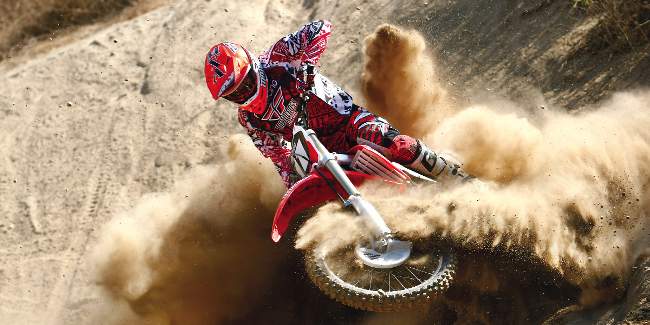
Q: FIRST AND FOREMOST, IS THE 2012 HONDA CRF250 BETTER THAN THE 2011 CRF250?
A: Yes! Is the 2012 Honda CRF250 significantly better than the 2011 model? No. Truth be told, Honda followed their typical strategy of making several minor updates instead of going whole hog. Why did Honda chip away at the CRF250’s bugaboos as opposed to starting from scratch? Let us review.
(1) Economy. Unless you own oil reserves in the Middle East, you’ve been affected by the economy. Honda hasn’t been immune to the downward spiral. Hence, it makes sense that Honda saved money on research and development.
(2) History. Honda’s engineers follow a predictable pattern. Need proof? The CRF250 was introduced in 2004. The next major changes to the bike came in 2007 (after three years on the market). In 2010, Honda once again redesigned the CRF250 (after another three years). Do you see a pattern forming? Since the 2012 model marks the third year of the current design, you might expect an all-new CRF250 in 2013. We aren’t. We’ll hedge our bets and say that Honda will release an all-new CRF450 in 2013, but not a CRF250.

2012 Honda CRF250: Honda didn’t make a plethora of changes to the CRF250, but instead focused on the problem areas. Most notably, the engine and suspension have been massaged.
Q: HOW MANY CHANGES CAN BE FOUND ON THE 2012 CRF250?
A: We count seven major updates.
(1) Throttle body. Honda took the electronic fuel-injection plunge in 2010 by opting for the Keihin 50mm throttle body (with 12-hole injector) from the CRF450. It was a smart move, because EFI eradicated the dreaded bog caused by the massive 40mm Keihin carburetor in 2009. For 2012, the CRF250 throttle body has been downsized to a 46mm unit. (This change was made on the CRF450 in 2011.) The goal was to produce a wider powerband with increased low-end and midrange torque. Honda tossed around the idea of going to a smaller throttle body in 2011, but the gains were minimal without changing the intake port on the cylinder head and air-boot size. For 2012, Honda buttoned up those issues.
(2) Cylinder head. Honda decreased the size of the intake port to work with the 46mm throttle body. The air boot has also been revised to match the smaller throttle body.
(3) Shock. The bell crank and shock linkage have been revised. This is the same linkage that comes on the CRF450. The pull rod is 4mm longer and matches the length of what aftermarket companies offer. Honda aimed at getting the CRF250 to ride lower in the rear and provide a more balanced feel. Valving in the Showa shock has also been stiffened in the initial part of the stroke.
(4) Forks. New, thicker front-axle collars provide more clamping area between the front-wheel bearings and fork lugs. The inside diameter of the axle collars is the same (meaning that older-model fork lugs will work on the 2012 CRF250), but the outside diameter is 2mm thicker. The collars are designed to add rigidity to the front end and increase steering precision. Honda also added 30cc of oil to the forks.
(5) Footpegs. The only way to differentiate a 2012 CRF250 from a 2011 is by looking at the footpegs (since the graphics are the same). Honda finally updated their archaic pegs. The new platforms are 7mm wider from stem to stern and 5mm longer from the frame to the tip. The ribs extending from the center of the pegs to the outside area have been removed to prevent mud buildup.
(6) Chain roller. Although the position of the chain roller is still the same, the size of the roller has been decreased. The new roller works with the linkage; at full extension, there’s less chain torque. This allows the suspension to work freely and not bind.
(7) Tires. Our prayers have finally been answered. Honda finally got rid of the awful Dunlop D742FA front tire. Sadly, the D756 rear tire was discontinued by Dunlop. For 2012, the CRF250 comes with a pair of Dunlop MX51 treads.
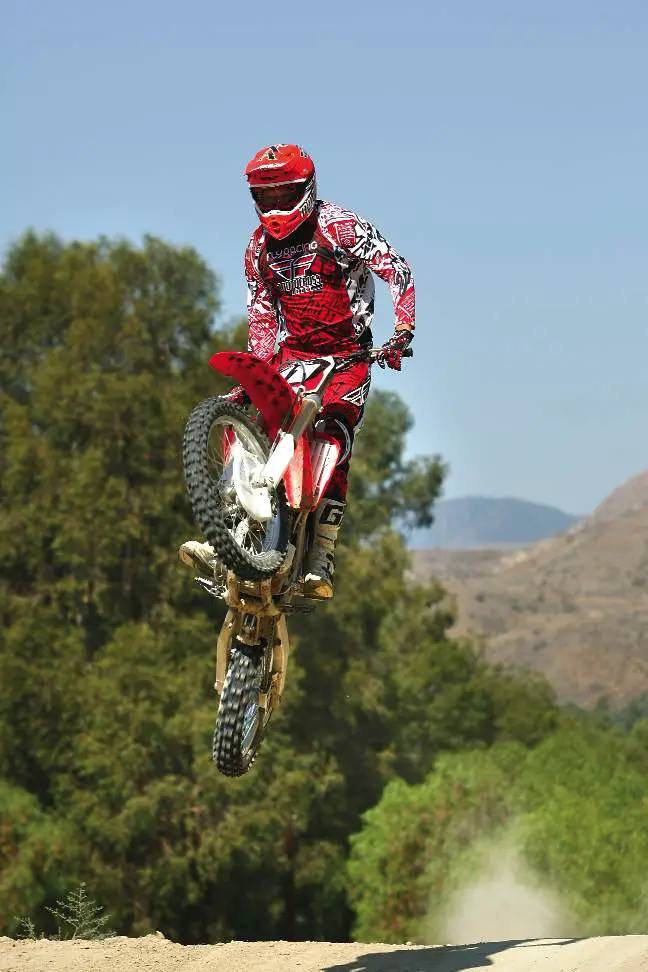
Air show: Testers loved how light and flickable the 2012 CRF250 was in motion. It’s the lightest EFI-equipped 250 four-stroke of the bunch. We only wish that the frame geometry was different.
Q: HOW WOULD WE DESCRIBE THE 2012 HONDA CRF250 POWERPLANT?
 Midrange monster: The CRF250 engine does its best work in the midrange. Test riders found it advantageous to shift often and keep the powerband humming from 7000 to 9000 rpm.
|
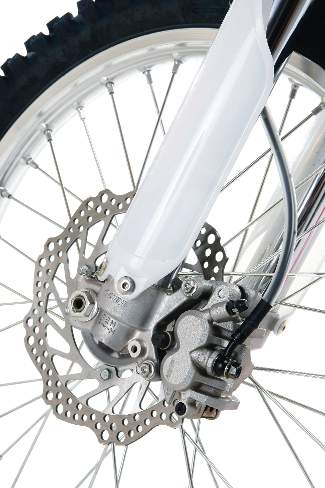 Free power: To improve front braking power, we removed the stock plastic rotor guard. It’s a free performance upgrade. |
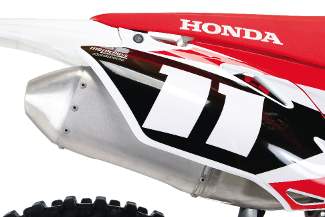 Choked up: The exhaust meets sound tests, which means you’ll need to buy an aftermarket system to boost power.
|
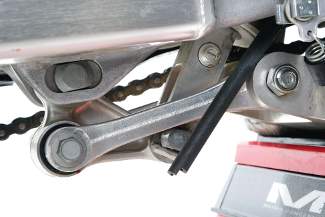 Balancing act: Honda changed the bell crank and lengthened the pull rod to help balance the CRF250 chassis.
|
A: Before we answer that question, we feel obliged to explain how the 2011 CRF250 engine performed. Best in the middle, the engine was excellent from just below midrange (7500 rpm) into the lower level of the top end (10,000 rpm). The engine was, however, hampered by flatness in the top end and a muffled throttle response. Using the engine effectively required constant shifting to stay in the sweet spot of the powerband.
Don’t be surprised to learn that the 2012 CRF250 engine is not worlds better. It’s true that the downsized throttle body added a dose of hit off idle, but without any major engine updates and a choked-up muffler, the powerband leaves a lot to be desired. In no way is the CRF250 a dog, but it’s far from the explosive powerband that it once was (particularly the carbureted 2008 and 2009 CRF250s).
The 2012 engine is competitive, but requires the rider to keep the throttle blasting through the midrange while his foot shifts gears in a hurry. There is little top-end power. It’s also futile to over-rev the engine, as test riders didn’t gain any ground when they refused to shift.
Q: IS HONDA GETTING CLOSER WITH THE FUEL INJECTION ON THE CRF250?
A: Yes. The downsized throttle body seems to flow its fuel more efficiently to the engine. It was very wise of Honda to redesign the cylinder head and air-boot intake to match the smaller Keihin throttle body. We do find it peculiar that, of all the manufacturers, Honda has tinkered the most with their fuel-delivery system. Back when the CRF250 was carbureted, they jumped from a 37mm carb to a larger-than-life 40mm unit. The upsized carburetor was a nuisance and nearly impossible to jet properly. Then, once Honda went the electronic fuel-injection route, they opted for a 50mm throttle body (perhaps because it was already in their parts inventory). Now, in an effort to pick up bottom-end and midrange power, they reduced the size of the throttle body. Apparently, bigger isn’t always better.
Q: HOW DOES THE 2012 CRF250 RUN ON THE DYNO?
A: Maximum horsepower on our 2012 CRF250 is 38.44 ponies at 11,000 rpm. Maximum torque is 20.00 foot-pounds. To compare those numbers to last year’s bike, the 2011 CRF250 reached 38.02 horsepower at 11,200 rpm. Maximum torque was 20.04 foot-pounds.
On the dyno curve, the power output on the 2012 CRF250 isn’t much different from last year’s. There’s a spike in horsepower from 6500 to 7700 rpm, followed by a steady but unimpressive climb to maximum horsepower at 11,000 rpm. The 2012 engine is roughly a 1/2-horsepower improvement at 9000 rpm and from 10,200 to 11,100 rpm.
Q: HOW DOES THE 2012 HONDA CRF250 STACK UP AGAINST THE COMPETITION ON THE DYNO?
A: Despite the fact that just one year ago the 2011 Honda CRF250 produced the most horsepower of any 250cc four-stroke on the dyno, but on the track the power advantage wasn’t much better than the competition. The 2012 CRF250 is marginally better than it was in 2011 at 38.44 horsepower, but it faces much stiffer competition. The 2012 Kawasaki KX250F pumped out a whopping 39.55 ponies. The CRF250 placed second in the dyno wars, followed closely by the Suzuki RM-Z250 (38.12 horsepower). In fourth place came the Yamaha YZ250F (37.13 ponies), while the KTM 250SXF reached a measly 35.52 horsepower.
Q: HOW DOES THE 2012 HONDA CRF250 HANDLE?
A: The odd frame geometry of the 2010 through 2012 Honda CRF250s won’t ever handle as well as the competition. Why? The relationship between the head angle, fork off, front center and weight bias are wrong. Having said that, the 2012 CRF250 handles slightly better than the 2011 CRF250, which was slightly better than the 2010 CRF250.
Over the past two years Honda has made incremental improvements to its wacky handling. Unfortunately, the geometry is just too radical. The front tends to knife in corners and head-shake with regularity. To Honda’s credit, they are aware of their mistakes and have taken some remedial steps to improve the situation. First, they beefed up the Honda Progressive Steering Damper (HPSD) in 2011. Second, they opted for thicker front-axle collars for the front wheel in 2012. Third, they lowered the rear of the chassis with a shock-linkage change, which, in turn, changed the head angle. Of all the changes, the linkage helps the most to stabilize the CRF250 at speed, but it is a band-aid for a chassis that oversteers into corners, understeers out of them and demands constant handlebar input.
The MXA wrecking crew is inclined to believe that the handling characteristics can be improved with the 2012 CRF250. Not fixed, but improved. How so? Half of the battle is getting the front and rear suspension balanced out, while finding a compromise head angle for your riding style. We run stiffer fork springs, slide the forks up and down until the chassis calms down, and try to run damping settings that hold the front end higher in its stroke. You should pursue the same strategy.
Q: WHAT WOULD WE DO TO IMPROVE THE 2012 HONDA CRF250?
A: Let us count the ways:
(1) Exhaust. The 2012 Honda CRF250 is quiet (it is two-meter-max legal at 115 decibels). In 2011, Honda decreased the muffler outlet diameter, changed the airflow inside the core and increased the overall length of the can by 100mm. Considering that the exhaust system is a carryover from last year, an aftermarket exhaust is in order. We had very good luck with the FMF Factory 4.1 system with the Megabomb header (www.fmfracing.com), as well as offerings from Pro Circuit and Yoshimura.
(2) Fork springs. Although Honda added oil to the fork legs, the 0.45 kg/mm fork springs are too soft for those over 165 pounds or faster than Novice speed. Jump up a spring rate and find solace in the fact that the investment is money well spent. Stiffer springs will help balance out the chassis and prevent bottoming.
(3) Front brake. We have a simple solution to increasing front-brake stopping power on the CRF250. Remove the rotor guard and press out the axle collar. The plastic guard restricts air to the front rotor, causing the rotor to overheat and lose pucker power.
Q: WHAT IS THE BEST FORK STRATEGY?
A: Here are a few tips that will help you get the most out of the 2012 Honda CRF250 suspension. Better yet, most of these setup tricks are free.
(1) Sag. The CRF250 is very sensitive to static sag. Honda suggests running between 103mm and 105mm of sag. We typically run 105mm of sag to balance out the bike.
(2) Fork height. Drop the fork legs until they are flush with the top triple clamp to improve straight-line stability.
(3) Steering stem. The HPSD isn’t the only damper on the CRF250. An old and useful trick is to tighten the steering-stem nut underneath the top triple clamp. Doing this will reduce front-end slack.
(4) Fork springs. Heavier and faster riders will find relief in stiffer fork springs.
(5) HPSD. Don’t be afraid to crank the HPSD steering damper in?it’s on the bike as a cure-all.
Q: WHAT WERE MXA’S BEST FORK SETTINGS?
A: For hardcore racing, these are MXA‘s recommended 2012 Honda CRF250 fork settings. (When changed, stock settings are in parentheses.)
Spring rate: 0.46 kg/mm (0.45 kg/mm)
Oil quantity: 357cc (372cc)
Compression: 8 clicks out (6 clicks out)
Rebound: 11 clicks out (10 clicks out)
HPSD: 9 clicks out (11 clicks out)
Fork-leg height: Flush with top clamp
Notes: We believe that any rider over 165 pounds would benefit from stiffer fork springs. If going to stiffer springs, remove fork oil in 5cc increments to reduce midstroke harshness. Also, stiffen the HPSD until you feel excessive drag on the handlebars.
Q: WHAT ARE OUR BEST SHOCK SETTINGS?
A: Here is what the MXA wrecking crew ran in its 2012 CRF250. (When changed, stock settings are in parentheses.)
Spring rate: 5.3 kg/mm
Race sag: 105mm
Hi-compression: 1?1/2 turns out (1?5/8 turns out)
Lo-compression: 6 clicks out (7 clicks out)
Rebound: 8 clicks out (9 clicks out)
Notes: The shock is very sensitive to high-speed compression. Heavier riders should go in 1/4 turn on the high-speed compression and set the sag at 100mm, but only if stiffer fork springs have been installed.
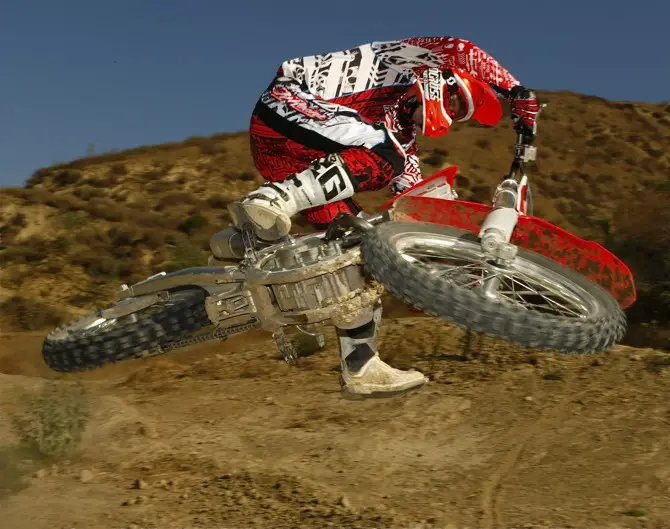
Q: WHAT DID WE HATE?
A: The hate list:
(1) Handling. Pro-level racers didn’t mind the CRF250’s odd-handling traits, while those less skilled hated the front-end oversteer and unbalanced feel. Is it bad of us to wish that Honda’s engineers never came out with the latest-generation frame and had stuck with the 2009 chassis?
(2) Brakes. While Honda used to have the best brakes in the business, they can say “sayonara” to that distinction. KTM rules the brake category, while the CRF250 now has the worst brakes in the class.
(3) Forks. The Showa units were a huge disappointment last year. They are marginally better this year, but still leave a lot to be desired. We think the frame geometry is mostly to blame.
(4) Graphics. Say, aren’t those the same graphics as the 2011 CRF250?
(5) Frame cradle. We find it ridiculous that aftermarket companies have to sell Honda-specific bike stands to keep the CRF250 and CRF450 level. The CRF250 sits awkwardly on a normal stand, with the rear wheel sky-high while the front tire digs into the ground.

Q: WHAT DID WE LIKE?
A: The like list:
(1) Engine. The smaller throttle body seems to boost low-end to midrange surge, and the engine pumps out over 38 horsepower. It’s not the king of the class on the dyno, but the CRF250 still packs a lot of ponies.
(2) Footpegs. For many years, MXA testers have complained about the footpegs. No more! The new pegs are beefy and do an excellent job of preventing mud from building up in the crevasses.
(3) Tires. Honda drop-kicked the horrible Dunlop D742FA front tire for a much more planted MX51. We’ll miss the D756 rear, which has been replaced by an MX51, but the tradeoff in front is worth it.
(4) Weight. The CRF250 is svelte. At 222 pounds, it is 4 pounds than the Yamaha YZ250F), but it’s the lightest EFI-equipped bike. At speed, the CRF250 feels extremely nimble (sometimes too nimble for its own good).
(5) Handlebars. You can’t go wrong with Renthal’s 7/8-inch 997 aluminum bars. They’re the preferred bend of the MXA wrecking crew.

Q: WHAT DO WE REALLY THINK?
A: We should reiterate that the 2012 Honda CRF250 is a decent bike that has many positive attributes. It has lots of potential. The engine is powerful, and the chassis feels light in motion. However, the frame geometry is too radical for our tastes, the suspension is suspect and the brakes are weak. We do know that with the addition of a few extra bucks and some well chosen aftermarket investments, the 2012 Honda CRF250 could be a much better bike. However, as it sits, the 2012 Honda CRF250 left us wanting more.





Comments are closed.